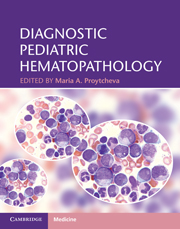Book contents
- Frontmatter
- Contents
- List of contributors
- Acknowledgements
- Introduction
- Section 1 General and non-neoplastic hematopathology
- Section 2 Neoplastic hematopathology
- 10 Chromosome abnormalities of hematologic malignancies
- 11 Expression profiling in pediatric acute leukemias
- 12 Myeloproliferative neoplasms
- 13 Myelodysplastic/myeloproliferative neoplasms
- 14 Myelodysplastic syndromes and therapy-related myeloid neoplasms
- 15 Acute myeloid leukemia and related precursor neoplasms
- 16 Hematologic abnormalities in individuals with Down syndrome
- 17 Precursor lymphoid neoplasms
- 18 Advances in prognostication and treatment of pediatric acute leukemia
- 19 The effect of chemotherapy, detection of minimal residual disease, and hematopoietic stem cell transplantation
- 20 Pediatric small blue cell tumors metastatic to the bone marrow
- 21 Pediatric mature B-cell non-Hodgkin lymphomas
- 22 Pediatric mature T-cell and NK-cell non-Hodgkin lymphomas
- 23 Hodgkin lymphoma
- 24 Immunodeficiency-associated lymphoproliferative disorders
- 25 Histiocytic proliferations in childhood
- 26 Cutaneous and subcutaneous lymphomas in children
- Index
- References
14 - Myelodysplastic syndromes and therapy-related myeloid neoplasms
from Section 2 - Neoplastic hematopathology
Published online by Cambridge University Press: 03 May 2011
- Frontmatter
- Contents
- List of contributors
- Acknowledgements
- Introduction
- Section 1 General and non-neoplastic hematopathology
- Section 2 Neoplastic hematopathology
- 10 Chromosome abnormalities of hematologic malignancies
- 11 Expression profiling in pediatric acute leukemias
- 12 Myeloproliferative neoplasms
- 13 Myelodysplastic/myeloproliferative neoplasms
- 14 Myelodysplastic syndromes and therapy-related myeloid neoplasms
- 15 Acute myeloid leukemia and related precursor neoplasms
- 16 Hematologic abnormalities in individuals with Down syndrome
- 17 Precursor lymphoid neoplasms
- 18 Advances in prognostication and treatment of pediatric acute leukemia
- 19 The effect of chemotherapy, detection of minimal residual disease, and hematopoietic stem cell transplantation
- 20 Pediatric small blue cell tumors metastatic to the bone marrow
- 21 Pediatric mature B-cell non-Hodgkin lymphomas
- 22 Pediatric mature T-cell and NK-cell non-Hodgkin lymphomas
- 23 Hodgkin lymphoma
- 24 Immunodeficiency-associated lymphoproliferative disorders
- 25 Histiocytic proliferations in childhood
- 26 Cutaneous and subcutaneous lymphomas in children
- Index
- References
Summary
Myelodysplastic syndromes
Definition
Myelodysplastic syndromes (MDS) in childhood encompasses a diverse group of clonal hematopoietic stem cell disorders, characterized by ineffective hematopoiesis with morphologic dysplasia, peripheral cytopenia, and an increased propensity to evolve into acute leukemia. MDS can arise either de novo in a previously healthy child (primary MDS), or develop in a child with a known predisposition as secondary MDS. In adult patients, most of the secondary MDSs are therapy-related, following cytotoxic therapy for prior neoplastic or non-neoplastic conditions. Secondary MDS in childhood includes many cases associated with constitutional bone marrow failure disorders, MDS evolved from acquired aplastic anemia, and familial MDS (Table 14.1), in addition to therapy-related MDS. It is noteworthy that the distinction of primary MDS and secondary MDS may not be clear cut in pediatric patients, since some of “primary MDS” may have an underlying, yet unknown, genetic defect predisposing them to MDS at a young age.
Epidemiology
Pediatric MDS is a rare hematologic malignancy of childhood. The reported incidence of pediatric MDS comprises 1.1 to 8.7% of hematologic malignancies of childhood, with an annual incidence of 1.8 per million in children of 0–14 years of age [1]. It constitutes 4% of cases, and is the third most common hematologic malignancy in children, following acute lymphoblastic leukemia (ALL) and acute myeloid leukemia (AML). In contrast to adult MDS that shows a male predominance (1.7 : 1), MDS in children affects males and females with an equal frequency.
- Type
- Chapter
- Information
- Diagnostic Pediatric Hematopathology , pp. 253 - 271Publisher: Cambridge University PressPrint publication year: 2011



